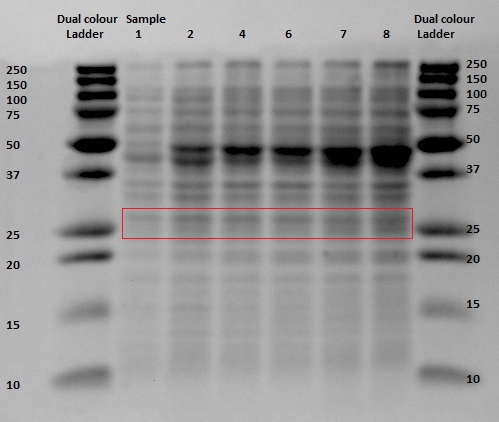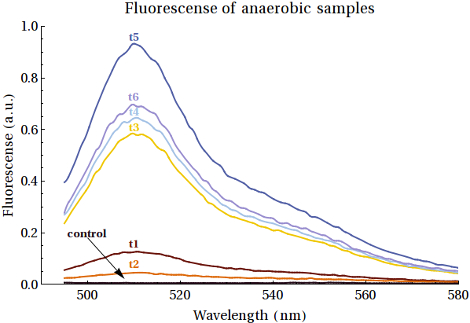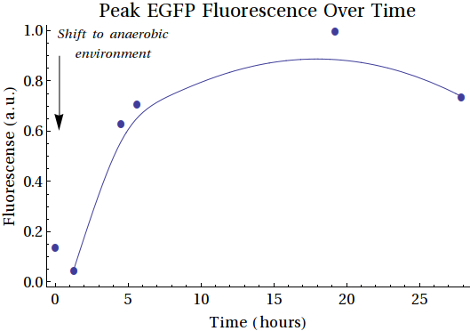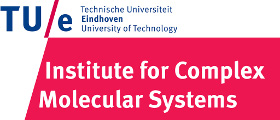Team:TU-Eindhoven/Results
From 2013.igem.org
(→Anaerobic FNR Testing) |
(→Anaerobic FNR Testing) |
||
| Line 24: | Line 24: | ||
{{:Team:TU-Eindhoven/Template:ImageListEnd}} | {{:Team:TU-Eindhoven/Template:ImageListEnd}} | ||
| - | We performed | + | We performed fluorescence measurements of the samples taken at different time points during the anaerobically induced expression of EGFP. These can be viewed below. |
{{:Team:TU-Eindhoven/Template:ImageList}} | {{:Team:TU-Eindhoven/Template:ImageList}} | ||
| Line 34: | Line 34: | ||
{{:Team:TU-Eindhoven/Template:FloatEnd | caption=Values of the peaks of the emission spectra of EGFP per sample | id=Emissionpeaks }} | {{:Team:TU-Eindhoven/Template:FloatEnd | caption=Values of the peaks of the emission spectra of EGFP per sample | id=Emissionpeaks }} | ||
{{:Team:TU-Eindhoven/Template:ImageListEnd}} | {{:Team:TU-Eindhoven/Template:ImageListEnd}} | ||
| - | These experiments resulted in the | + | What becomes clear from the fluorescence measurements is that the amount of EGFP is indeed increasing in accordance with increases in the time. (Which also confirms that the low intensity bands seen in the gels above were in fact EGFP). These experiments resulted in the conclusion that we have two more functional Biobricks: [http://parts.igem.org/wiki/index.php?title=Part:BBa_K1123000 BBa_K1123001] and [http://parts.igem.org/wiki/index.php?title=Part:BBa_K1123005 BBa_K1123005]. |
To see detailed information and results, see [https://2013.igem.org/Team:TU-Eindhoven/AnearobicTesting Anaerobic FNR Testing]. | To see detailed information and results, see [https://2013.igem.org/Team:TU-Eindhoven/AnearobicTesting Anaerobic FNR Testing]. | ||
Revision as of 01:30, 5 October 2013



Contents |
Main Results
Aerobic Expression
In the experiments for the aerobic expression of the proteins, we saw that we were able to produce a number of proteins correctly. The proteins 1ETF, 1PJN, 1G70 and EGFP were visibly produced and purified by means of their His-Tag and/or exclusion body extraction. The other proteins we had designed were not seen as clearly, many not all, after expression, however, for most of these proteins, we did end up seeing CEST contrast. We can conclude that the following Biobricks were expressed most succesfully: [http://parts.igem.org/Part:BBa_K1123014 BBa_K11230014], [http://parts.igem.org/Part:BBa_K1123015 BBa_K1123015], [http://parts.igem.org/Part:BBa_K1123016 BBa_K1123016] and [http://parts.igem.org/Part:BBa_K1123017 BBa_K1123017]. For more detailed information and further results obtained during these experiments, see CEST Agent Testing.
CEST Agent Testing
To evaluate all the potential CEST contrast agents, MRI measurements were carried out and analyzed as described in MRI Data Processing. The most promising agents seemed to be the lysine based contrast agents. All compounds that have a high lysine percentage expressed lysine based CEST contrast. The best distinguishable agent was 1PJN ([http://parts.igem.org/Part:BBa_K1123015 BBa_K1123015]), based on the graph below ().

Anaerobic FNR Testing
After analyzing the samples taken during anaerobically induced expression of EGFP, we can conclude that the FNR promoter is a functional Biobrick. This conclusion was made after viewing the understanding gels and noticing the increased intensity of the bands related to the EGFP protein.


We performed fluorescence measurements of the samples taken at different time points during the anaerobically induced expression of EGFP. These can be viewed below.


General Result
As a general result of all the experiments we have a promising CEST contrast Agent and we have a functional FNR promoter, which can be induced anaerobically at 37°C and produces more protein when it is longer exposed to the hypoxic conditions. Overall, we showed that all the seperate mechanisms are working and that the combined functions are functional too. The proof of concept seems to be promising, but further experiments, such as in vivo experiments and experiments to ensure the killing mechanism is working well, need to be performed to say whether this could really be used for tumor targetting.
 "
"



